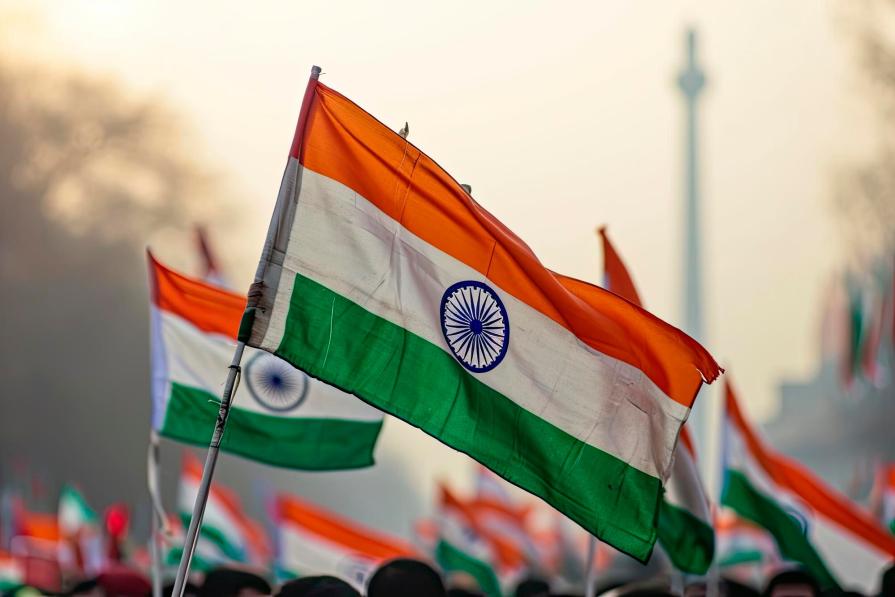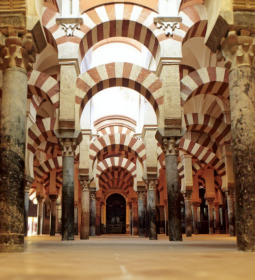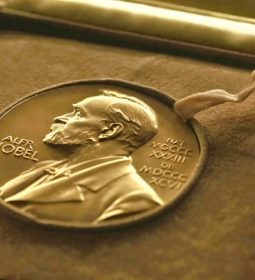Initially, the white-green-red flag was approved in 1921 as the official flag of the Indian National Congress movement, the largest party in India of the colonial era. Religious associations were assigned to the flowers: for green - Muslim, for red - Hindu, and white color was intended for everyone else. According to another version, white appeared on the flag by analogy with the Irish flag: there was also the task of buffering (between Catholics and Anglicans), and the struggle for independence from the empire was a priority.
In the center of the white stripe was painted blue charkha - a traditional spinning wheel, which was supposed to personify the desire for independence and freedom.
In 1931, the flag was updated: the stripe instead of red became saffron,and the symbolic meaning of the flowers was cleared of the religious component. From now on, white was peace and truth, green meant prosperity and loyalty, and the aforementioned saffron meant courage and bravery.
During the Second World War and soon after its end, the independence movement became more radical, and in 1947 India came close to freedom. At the constituent assembly, a flag was adopted, where the spinning wheel was replaced by the dharmachakra - the wheel of law, an ancient symbol of King Ashoka, the first Indian emperor and lawmaker belonging to the Maurya dynasty. The symbol had a second, Buddhist meaning, because the Buddha is the Dharma. There is also a difference: instead of the Buddhist eight spokes, the Ashoka wheel has 24 – according to the number of hours in a day.
The second president, the philosopher Radhakrishnan, gave the flowers and symbols a new interpretation:
- bhagva, or saffron – self-denial and impartiality, because our leaders are obliged to be silverless and put duty above all.
- White is the way of truth, its search.
- And green symbolizes the attitude to the world of plants and the earth.
- The wheel is unchanged: the wheel of the Dharma law, also meaning movement and life as the antithesis of death.

History
When British power replaced the power of the Mughals, the flags of these lands were the banners of the trade campaigns - Bengal and East India. In the French and Portuguese settlements of Pondicherry, Goa and Bali - respectively, the flags of the colonial administrations of these countries.
That all changed in 1858 when British India was created. From that moment on, union Jack fluttered over the vast territory uniting present-day India, Pakistan, Bangladesh and Burma.
Since 1880, local associations and societies have been able to use the national flag with British crosses in the upper left or right corners at events. Most often it was about the colors of the local maharaja, nabob or other ruler.
At the beginning of the XX century, against the background of the unfolding struggle for independence, the question of the flag of the nation arose. Sister Nivedita came up with the idea of a red rectangular cloth with a yellow zipper and a white lotus, with the inscription "Homeland" in Bengali. Poetic Hindus deciphered colors and symbols as follows:
- red – the way to independence
- yellow is a victory on this path
- lotus of white color - purity of thoughts.
The first tricolor was raised in August 1906 during protests against the partition of Bengal in Calcutta. It became known as the flag of independence and was a cloth of three equal colored stripes - orange, yellow and green, from top to bottom. The upper band was complemented by eight lotus flowers, which symbolized the provinces of British India, and on the lower freely located the sun and crescent with a star. The middle band served as the background for the Hindi phrase "I worship you, mother." This line is a quote from a hymn of praise in honor of the goddess Durga, the "totem" Indian goddess.
In August 1907, Indian nationalists at a meeting in Stuttgart, Germany, presented another national flag – green-yellow-red, with the same symbols, but without an inscription. White symbolized Buddhism and Sikhism. The authors of the flag were Kama Bhikahaji Rustom, Vinayak Damadaro and several other Indian intellectuals.
Subsequently, during the First World War, this sign was used by the so-called "Berlin Committee" - a group that advocated the independence of India. The banner was often used by Indian defectors and Pakistanis who fought on the side of the Ottoman Empire on the Mesopotamian front.
On another continent - in America - the flag of the Gadar party was used as a national symbol, but it was never destined to become popular in the colony or Europe.
In 1916, Pingli Venkaya and Umar Sobani founded the "Mission of the National Indian Flag", they tried to convince mahatma Gandhi to accept their project, but to no avail, since the flag did not reflect Indian religions.
In 1921, Gandhi himself entered the case - on his version of the national flag was depicted a spinning wheel as a symbol of hope for independence and freedom, and the colors symbolized religions (white was "given" to Christians and Sikhs, as well as other minorities). The new flag was used at the party gathering in Ahmedabad in 1921. Having not received official recognition of the National Indian Congress, however, it was actively used for demonstrations and demonstrations. Minorities, by the way, did not appreciate their "white": the Sikhs wanted "their" yellow color to appear on the flag, others insisted on placing some additional symbols.

In 1931 the Working Committee of the Congress met; he created a flag commission whose work proposed a monochromatic red flag. It was used for a short time, but was eventually rejected by the INC due to parallels with the red flag of the Communists.
A year later, the final resolution approved the version in its current colors, clearing their symbolic meaning of religious background; in the center placed a blue national spinning wheel - charkha.
During World War II, the puppet pro-India government of Azad Hind used another variant with the words "Azad Hind" – "Free India" – and a tiger in the jump. Over the Indian lands, this banner was destined to fly for a short time - in 1944-early 1945; a noose awaited the collaborators.
In 1947, in preparation for the declaration of independence, it was decided to replace the spinning wheel on the flag with the wheel of the legalists - the dharma chakra. Since then, the flag has remained unchanged, only the rules for its use have changed.
How can and cannot the flag of India be used?
Until 2002, civilians could only hang the flag during holidays. This would have continued in the future if not for Madhya Pradesh, a businessman who entered into a polemic with the state and defended in the high court of Delhi the right to use the flag in his own office.
The confrontation had a tragicomic connotation: he hung a flag, the police came, confiscated and issued a fine, and so several dozen times. The court took into account the consequences of such a company and recommended the creation of a special commission to amend the provisions of the law. This happened in January 2002: all Hindus without exception received the right to raise flags on any day, subject to strict rules. In the event that these rules are not met, the offender may face a huge fine and a prison sentence in addition to the inevitable confiscation of the flag. The government of the country refers to the disrespectful attitude, in addition to the actual disrespect, the use of non-standard symbols.
For example, in 2017, mats in the colors of the Indian flag that went on sale on the Amazon service caused a diplomatic scandal: the country's authorities decided that this was a manifestation of disrespect and insult, and demanded to withdraw them from sale - otherwise the store employees would be deprived of the right to receive Indian visas.
The corporation went for an apology and withdrawal from sale.
Manufacturing rules
After the proclamation of the republic in 1950, the Country's Bureau of Standards strictly standardized the production of state symbols. So, it is allowed to manufacture flags of only 9 sizes - from a miniature 150 by 100 millimeters to an impressive 6300 by 4200. All other sizes are prohibited.
In 1968, the rules were adapted to the metric system of measures – previously India used the imperial one. The smallest details are regulated, up to the size of the thread and the cord with which the flag is raised (it must be made of hemp fiber). Any deviation from this process may result in a fine and a prison sentence.
The fabric from which the flag is made is hadi,or hand yarn. It is allowed to make it from cotton, wool or silk, synthetics are prohibited.
More than 40 million flags are sold annually in the country – with hadi produced in only two factories in the northern part of Karntataka, and flags – at all in a single factory.












